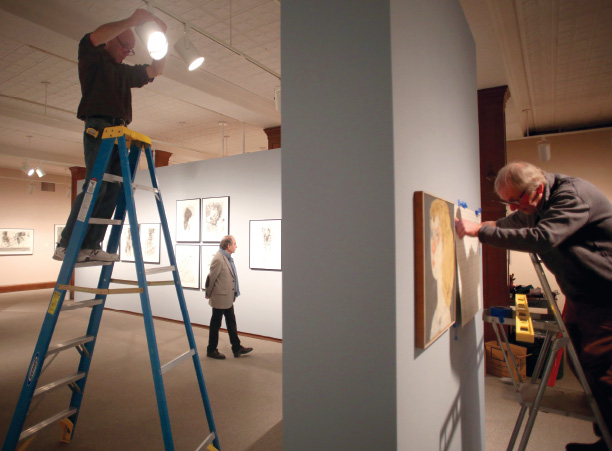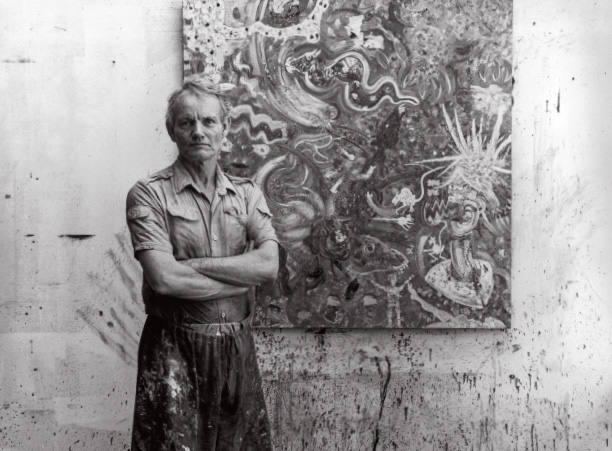Roger Hankins makes his way to the studio on Bethuen Street in Manhattan"s West Village every six months or so. Behind the pale-yellow concrete exterior and brass and glass doors, dozens of painted canvases lie vertically on racks, some as large as five feet across. Hundreds more drawings and sketches, stored in flat file drawers and portfolios, fill the space, along with a worktable in the center of the room.
The canvases and papers are alive with shapes, people, animals and objects, all drawn with the sharp lines, flattened forms and distorted imagery typical of the expressionist art movement.
The artist is acclaimed expressionist Robert Beauchamp (pronounced "Bee-chum"), who was renowned for his paintings and drawings from the 1950s until his death in 1995.
Beauchamp lived and worked in this Manhattan studio, and also spent time in Wellfleet, Massachusetts. Major galleries in both locations and across the United States exhibited his work during his life, including the Museum of Modern Art and the Guggenheim in New York, as well as galleries in Provincetown, Massachusetts.
His widow, Nadine Valenti Beauchamp, also an artist, maintains this studio space for her own painting, as well as to store her husband's legacy, a sizeable portion of which has become a permanent part of the fine art collection at Holy Cross.
Hankins, the director of Holy Cross' Iris and B. Gerald Cantor Art Gallery, has been making visits to Valenti Beauchamp and the studio since the early 2000s, when Holy Cross Professor of English and Stephen J. Prior Professor of Humanities Maurice A. Géracht first introduced them. Géracht, an avid fan and collector of Beauchamp's work, is a close friend of Valenti Beauchamp and knew she was thinking about which institution would be best for housing her husband's valuable artwork. Géracht was convinced Holy Cross was the place.
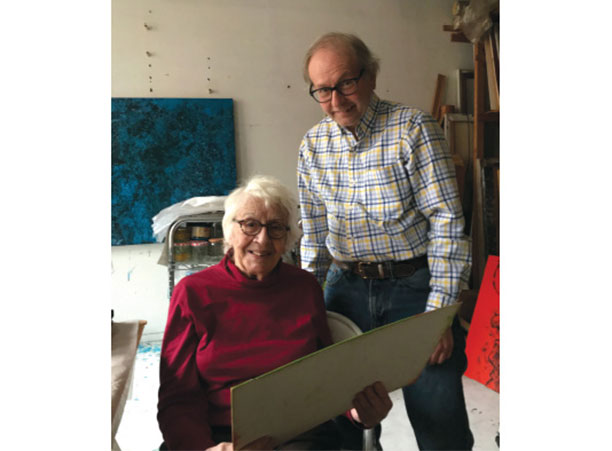 Nadine Valenti Beauchamp and Roger Hankins in the studio of NVB, New York, January 2018. Photo courtesy of Nadine Valenti Beauchamp
Nadine Valenti Beauchamp and Roger Hankins in the studio of NVB, New York, January 2018. Photo courtesy of Nadine Valenti Beauchamp"Over the number of years I went there, it was a process of educating myself about his work and also understanding the ways in which we at Holy Cross could relate to the collection and how it could best serve the College," Hankins says.
At that same time, Valenti Beauchamp was focused on preserving the art for future generations of art students and scholars. She wants his work to be used as a teaching tool and put on display in exhibits — rather than stored in some dark university or museum archives — as Beauchamp himself was an art teacher.
The more time Hankins spent in Beauchamp's studio, the more he, too, was certain that Holy Cross was the best home for this art.
"It became really apparent to me, while looking through the drawings with Nadine, that there was an awful lot of material that was extremely useful in a pedagogical way. So I pitched the idea to both Nadine and the College administration to house and archive these valuable materials," Hankins says. "This is material that could really be used by our art students and others, to learn from in a very direct way."
Hankins proposed the idea — with Géracht's rousing endorsement — around 2012, and Valenti Beauchamp began the process of cataloguing and organizing all of her husband's work. By 2016, she had donated more than 700 of her husband's works on paper to Holy Cross and the Cantor Art Gallery, making it the largest art donation in the history of the College.
Géracht also contributed 100 of his own personal Beauchamp works. Some of these pieces have never been displayed publicly, and the generous donation doubled the size of the gallery's fine art collection. Although there were a few drawings already in the collection, this donation represents the first substantial gift of drawings to the Cantor collection since the gallery was founded.
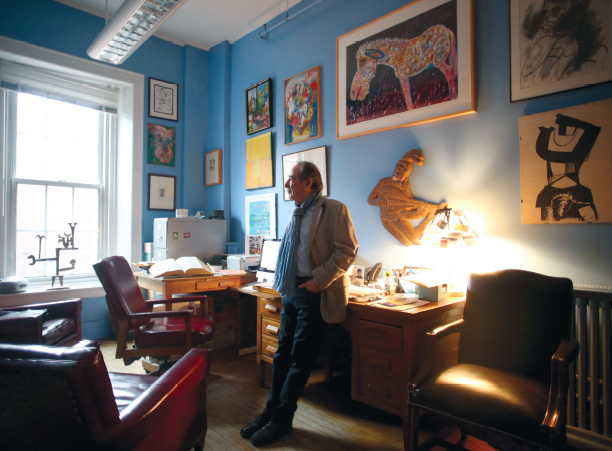 Maurice A. Géracht, professor of English and Stephen J. Prior Professor of Humanities, in his office surrounded by several of his personal Beauchamp pieces, was instrumental in the donation of the collection to the College. Photo by Tom Rettig
Maurice A. Géracht, professor of English and Stephen J. Prior Professor of Humanities, in his office surrounded by several of his personal Beauchamp pieces, was instrumental in the donation of the collection to the College. Photo by Tom RettigIt took several years for the donation to come to fruition because Valenti Beauchamp needed time to categorize and organize the drawings, grouping them by decade in some cases and style in others. But this also gave Hankins an unprecedented opportunity to be involved in this process and select the drawings that would be most useful for the College.
"This is a pretty unique situation, because most large collection institutions would not have the time to devote to doing this kind of forensic work on a single artist's collection," Hankins says. "Their resources are generally stretched to cover a lot of research. But this is Holy Cross and the Cantor Art Gallery, and we work hard to bring important exhibitions to the College, our students and faculty. We often tackle projects that are seemingly impossible for a small college gallery with a staff of two people. When working with Nadine, I could devote more attention and time when it wouldn't conflict with our academic year exhibition schedule; the summer months generally worked best to organize the details and logistics of this substantial gift of art."
Valenti Beauchamp, with the assistance of a graduate art student, took on the bulk of the organizational work, and Hankins calls her "the real heroine" of that process.
"She is very self-sacrificing in terms of trying to preserve the legacy of Robert Beauchamp's work and what he did," Hankins says.
"The Cantor staff and our faculty see how important these pieces are as teaching tools, so it works for the mission of the gallery and for what Nadine wishes for her husband's collection," Géracht adds. "It's a win-win all around."
The College's Cantor Art Gallery was established in 1983 and presents four to five original and loan exhibitions every year in the 1,800-square-foot gallery space. The gallery also plays host to receptions, guest lectures, readings and student presentations throughout the academic year, serving as a hub of art appreciation for all facets of the Holy Cross community.
"Visual art is not exclusive for art students. A gallery like ours exists to introduce people to the art-making process and creativity. We develop exhibitions in very complex ways that tell a well-rounded story," Hankins says. "It's more than, ‘Here's a work of art with a short description.'"
One of the goals for the Beauchamp exhibition was to emphasize the processes an artist uses when creating art.
"Dedicated practice is what made his work exceptional, and that's what these drawings represent — you can see persistence of his discipline over and over again," Hankins says. "When we selected the pieces for the show, we wanted to have as many pieces as possible so that visitors get a sense of the sheer volume of both Beauchamp's output of drawings and the volume of the resource that we have here on campus now. I can't do a show with 700 drawings in it, but this is a peek into the riches in the entire collection."
The collection spans from the early 1960s to Beauchamp's death in 1995, and includes drawings of humans, animals and objects, all done in his signature expressionist style. Expressionism was a movement in the early 20th century wherein artists distorted the image of reality in their work in order to evoke emotions in the viewer and convey their own inner feelings or ideas.
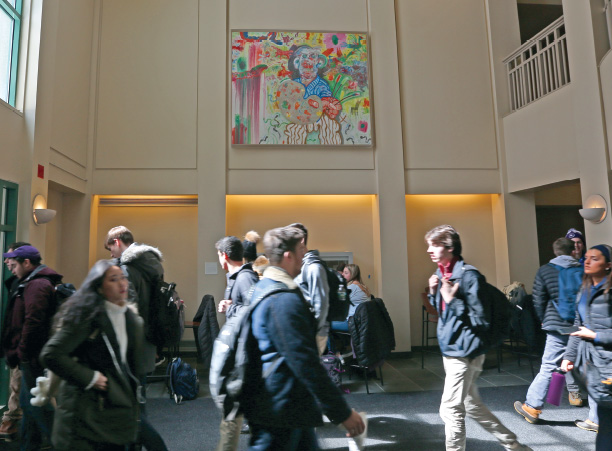 A Beauchamp self-portrait, "Artist in His Studio," hangs inside the entrance to Stein Hall. Photo by Tom Rettig
A Beauchamp self-portrait, "Artist in His Studio," hangs inside the entrance to Stein Hall. Photo by Tom Rettig"A traditional subject, the treatment is anything but conventional," Géracht writes of this painting in his scholarly article, "Robert Beauchamp (1923-1995): Self-Portraits." "The struggle to affirm his and our humanity, as well as his questioning of its course, lie at the center of Beauchamp's work, and especially so in his late portraits.
"Large round dark blue eyes stare out unblinking; one red and one yellow pupil ... The artist holds the oversize palette flat against his body, like a shield, at once presenting it ready for progressive action and active defense … It is a dense world of accreted colors and personal images in which the lyrical and the threatening, the comic and the tragic, despair and joy, the silly and the serious, order and the absurd, co-exist not as separate entities alongside one another, but which reverberate in the very same paint speckles, slashes, splotches, saturated hue and drips, as well as drawn images which make for the painterly surface."
While that painting is on public display in Stein, storing multiple large canvas paintings is another story. The storage space for the Cantor's collection is modest, and it was most practical for the paper drawings — as opposed to any canvas paintings — to be part of the collection. Where some might see the space issue as a limitation, Hankins sees the benefit in focusing on a representative selection of Beauchamp's drawings, as opposed to a few paintings on stretched canvas.
Studying the Process
For art students, the Beauchamp collection is an unparalleled opportunity to study the progress of a piece of art, from beginning sketches to final product, Hankins says.
"It is very rare for students to have an opportunity to see how an artist thinks. By having 100 drawings of a similar portrait, you really have an opportunity to see just how he arrived at certain pieces," Hankins says. "You can see some of the earlier stages, the different variations, how he developed a particular way of doing a portrait.
"That is why this collection makes so much sense in an educational setting, as opposed to stored in a museum vault and only occasionally selected for an exhibition," he adds. "This gives us an opportunity to really have the drawings out and be able to teach from them, and repeat that frequently for various faculty and students, because good drawings often have a timeless quality about them."
Leslie Schomp, a lecturer in the visual arts department since 2000, was a co-curator of the exhibition of Beauchamp's work, and relished the opportunity for her drawing students to learn from the artist's techniques. She took her classes to the exhibit and also worked with Hankins to schedule separate visits to the Cantor Gallery to look at Beauchamp pieces that were not on display.
Hankins frequently hosts art classes and other academic departments in the gallery, selecting pieces from the collection's storage area for student viewing. He says it is a completely different way to interact with art, compared to seeing it on a wall, behind glass and in a frame.
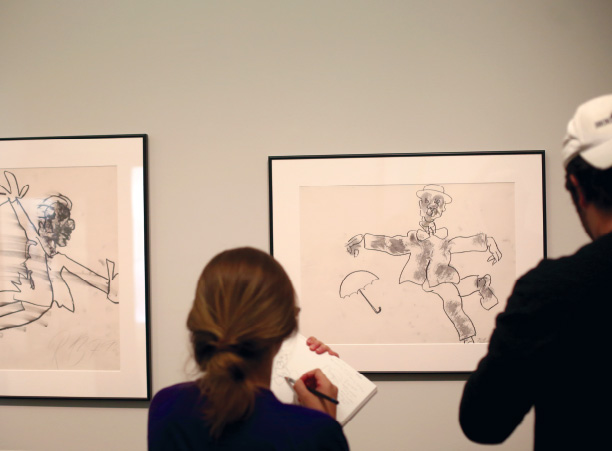 Students study Beauchamp drawings in the hallways outside the Cantor Gallery. Photo by Tom Rettig
Students study Beauchamp drawings in the hallways outside the Cantor Gallery. Photo by Tom RettigClaudia Davila '20, a student in Schomp's Intermediate Drawing class, visited the Beauchamp exhibit multiple times. On each visit, she found herself captivated by a drawing of a bicycle.
"I saw the bicycle drawing three different times, and at first, I thought it was falling to the right. It seemed static," says Davila, a psychology major with an art minor from Lima, Peru. "The second time, I noticed that it had paint splattered to the left and that the bicycle was tilted, making it seem like it was rolling down a hill at an angle. I realized that since I looked at the drawing on several different days, I paid more attention to what I didn't know than what I already did. Beauchamp's drawings showed me how there is always a different way to look at things and interpret them."
Schomp's classes also explored the different drawing materials Beauchamp used — he experimented with charcoal, pencils, colored pencils, even mineral spirits and graphite — and what effect these materials had on the texture of the drawing.
No matter which aspect of his technique they were studying, Schomp made sure that students saw the process of creating the piece and the hard work that goes into making art.
"We are able to see where he was really successful and where he was working toward that success. Magic is not some instant thing that just happens," she says. "I really believe, from looking at this huge body of work, that he worked really hard to get this magic. It took an incredible amount of work ethic, commitment and trying it again and again. In respect to the students, that can be taught. That can be shown."
Lily Ryan '21 got that message when she visited the Beauchamp exhibit with Schomp's Intermediate Drawing class.
"I thought it was very interesting how some of his experimental drawings and sketches became the pieces of artwork displayed in the gallery," says Ryan, who is from Scituate, Massachusetts, and undecided on a major. "They weren't clean and structured, as final pieces are, but they became his final pieces because he embraced the rawness of his work [during the process]."
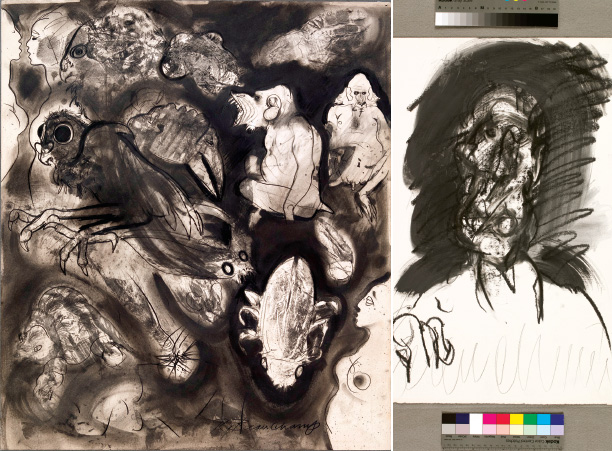 Untitled, c. 1970s, powdered graphite wash, litho crayon, graphite, 30" x 26." And Untitled, 1977, ink, powdered graphite wash, litho crayon, graphite, 24" x 18" is shown on a middle grey background with Kodak Color Control Patches at the top and bottom of the piece so that the drawing, when photographed, is captured as close as it would appear in person.
Untitled, c. 1970s, powdered graphite wash, litho crayon, graphite, 30" x 26." And Untitled, 1977, ink, powdered graphite wash, litho crayon, graphite, 24" x 18" is shown on a middle grey background with Kodak Color Control Patches at the top and bottom of the piece so that the drawing, when photographed, is captured as close as it would appear in person.Beauchamp also frequently sketched author portraits of the likes of Irish author Samuel Beckett and English writers Joseph Conrad and Virginia Woolf. He also often drew characters from James Joyce stories. Géracht and his fellow English faculty members plan on utilizing the many author and book character portraits in the Beauchamp collection, examining the drawings in relation to the text of these authors.
"Through his art, one of the things Beauchamp does is to examine the continuum in the human condition — in both facing the dark side of the human condition as well as the joy — within the same drawing or painting," Géracht says. "People like Beckett, Conrad, Woolf and Joyce did that as well, in their writing."
Down the road, the Cantor Art Gallery will have a larger, more robust storage space in the new gallery location in the Center for the Arts and Creativity, one of the projects of the Become More campaign. There's a chance that some of Beauchamp's large canvas paintings could find a permanent home on Mount St. James, but at the very least, there will be a resource room directly connected to the gallery where students, faculty and scholars can visit and immerse themselves in the artist's work.
"Now is the right time for this show — and for Beauchamp's work to come to campus — because of the environment we have here, with all kinds of arts programs taking place and interacting with one another," Hankins says. "There is much more awareness about the arts on campus, and this is another great thing that the Cantor Gallery can offer the campus."
Hankins, along with Paula Rosenblum, the gallery's assistant director for communications and operations, always emphasize service to the College community in their work. Their willingness to go above and beyond — coupled with Valenti Beauchamp's generosity — made this historic gift to the College possible.
"You could not want a greater, more passionate, more meticulous, more talented director of gallery than Roger," Géracht says. "He is the crème de la crème. We are so lucky to have him. He and Paula do an incredible job — exhibition after exhibition, they are the top."
Written by Maura Sullivan Hill for the Spring 2018 issue of Holy Cross Magazine.
About Holy Cross Magazine
Holy Cross Magazine (HCM) is the quarterly alumni publication of the College of the Holy Cross. The award-winning publication is mailed to alumni and friends of the College and includes intriguing profiles, make-you-think features, alumni news, exclusive photos and more. Visit magazine.holycross.edu/about to contact HCM, submit alumni class notes, milestones, or letters to the editor.
